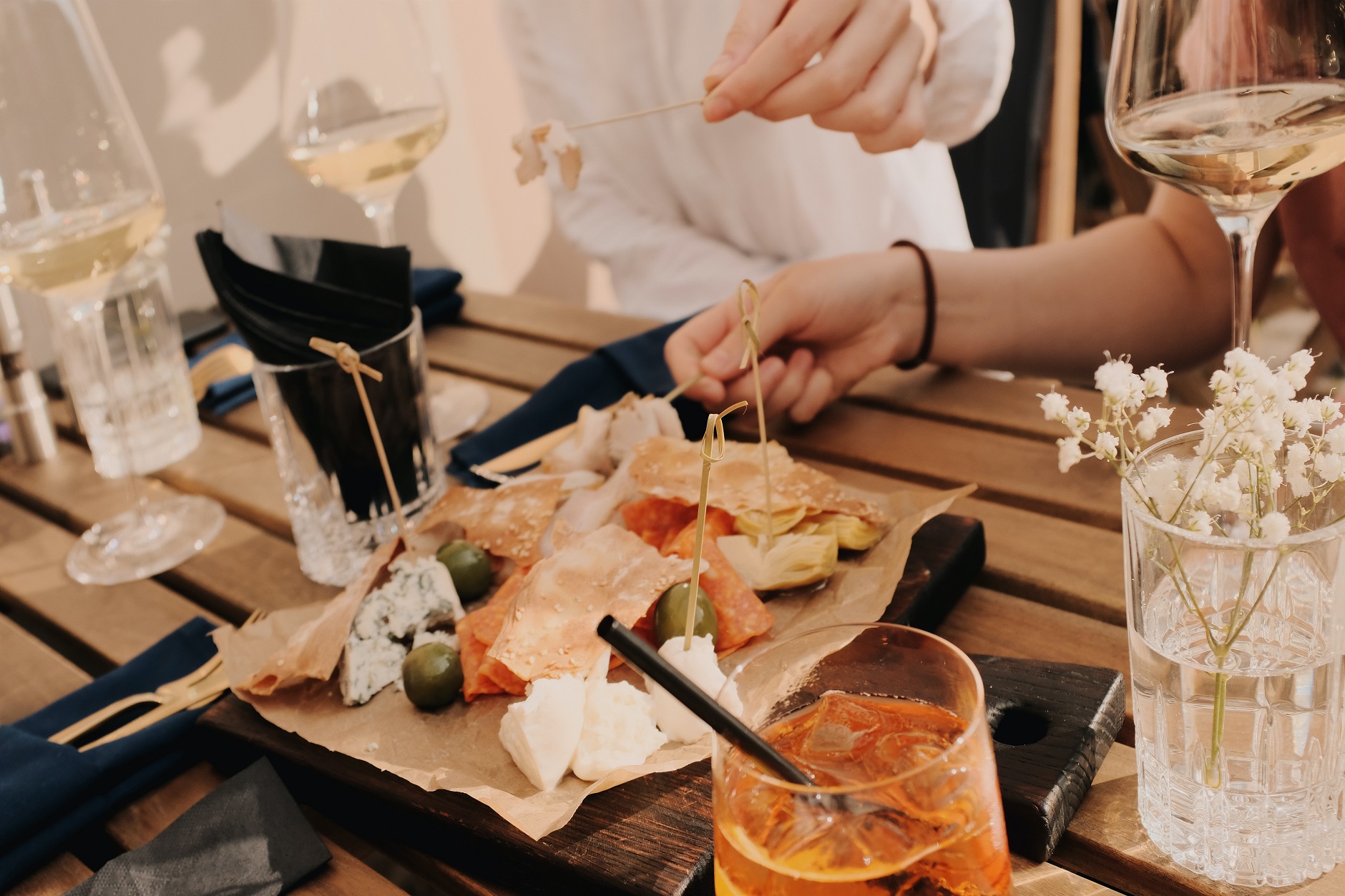It's a ritual, a tradition, a time to be together, and a guaranteed stress reliever. In short, the Italian 'aperitivo' is one of the most delightful moments of the day, don't you think? Let's find out how it came about, tips on how best to organise it, which wines should not be missed and... some interesting facts on how it is enjoyed in other parts of the world.
APERITIF, ITALIAN STYLE: HOW THE DAY'S MOST DELIGHTFUL MOMENT WAS BORN
We owe the invention of this delicious ritual to the ancient Greeks: in the 4th century B.C., the physician Hippocrates discovered that a few glasses of a bitter-tasting drink made of white wine, rue, wormwood and dittany flowers was enough to help those suffering from lack of appetite (a problem that a true gourmand like you probably never experienced). What they called 'vinum hippocratum' (after the name of its inventor) was passed down through the centuries, until it was mixed in the Middle Ages with precious spices from the East to become the spiced 'aperitif wine' that so many began to appreciate.
The effect of the aperitif (from the Latin 'aperitivus', i.e. 'that which opens') is precisely that of stimulating the appetite before a more substantial meal: the secret lies in the bitter taste of the drinks, which stimulates the taste buds and, in practice, 'opens the stomach', making us feel that typical pre-dinner pang. If you think about it, even today typical aperitif drinks are rather bitter... but how did we arrive at the aperitif we know today?
Turin, 1786: in his liquor shop, Antonio Benedetto Carpano had the intuition that will be the turning point for all our drinking. Experimenting, he created a bitter drink and its success was such that it turned that 'little glass before sitting down to eat' into the most popular court ritual. In all the city's cafés, the aperitif became immediately popular and was often accompanied by cheese and charcuterie snacks.
We really must say 'thank you' to Antonio for giving us the most relaxing moment of the day, don't you think?
APERITIF, ITALIAN STYLE: WHICH ARE THE MOST SUITABLE WINES?
After a plunge into history, back to business: a true winelover like you must always be sure to have the right labels in their cellar for an aperitif. Here you will find bottles that can save you even for last-minute toasts – ready? Let's get started!
If you can't resist the allure of pink, you should always keep a bottle of RAGGIANTE ROSATO in the fridge: elegant and soft, it's simply perfect with the most delicious hors d'oeuvres and finger foods, even exotic ones. Excellent with fusion dishes, it should be enjoyed between 10° and 12° to fully appreciate each glass: you'll see how delightful it is to sip between canapés... what do you say, shall we uncork it?
For fans of fresh, fruity whites, the EVENTUS BIANCO is a must-have: whether it is that softness, that balance, or those intense hints of yellow apple, pear and grapefruit... the fact is that it is impossible to resist: try it with cold fish starters or with warm seafood salads and you will appreciate all its nuances. Ah, don't forget to chill it and serve it between 8° and 10° (the details make all the difference!).
For the 'coolest' evenings, those that start with an aperitif and then end up chatting under the stars until midnight, the 7PM is the ultimate solution: excellent with fish canapés, spectacular with shellfish, it's the label that transforms your evening as soon as you pop the cork. It can accompany you throughout a meal (just in case you get peckish and improvise some midnight spaghetti) and you can put it in the fridge a few hours before your friends arrive, then... party on!
Don't worry, we haven't forgotten the more indomitable gourmets, those who enjoy a nice platter of cured meats and mature cheeses or a plate of game even in the height of summer: for these champions of strong flavours, a dry red is needed, such as the EXCLUSIVO ETICHETTA ORO ROSSO PUGLIA IGT. Aged in oak barrels, it's full-bodied and well structured on the palate, enveloping and harmonious despite the very pronounced tannin. It is at its best between 18° and 20°, even with a simple crust of bread and salted beef.
APERITIF, ITALIAN STYLE: TIPS FOR PERFECT ORGANISATION
Even the heaviest day can be lightened by an aperitif in good company. And if you are one of those hosts who always likes to have friends to toast with, here are some tips for organising your happy hour to perfection.
First, make sure you have the right glasses: don't panic, you don't have to fill the house with glassware. To be ready for all eventualities, you can lay the table with a set of tulip glasses, ideal for sparkling whites and rosés with a delicate aroma: with this type of glass, you can not only enjoy the dance of the perlage (which in itself is immediately cheerful) but you can manage to serve different types of wine with the same glass, perhaps taking care to rinse it before uncorking a new label.
Space management, especially if you have many friends to toast with, is crucial: you should always set up a table (even a small one) or a space to place glasses and canapés even during a stand-up party. It wouldn't be nice to leave your guests standing with a glass in one hand and a napkin with a canapé in the other.
Speaking of napkins: they can never be absent yet at the same time are no substitute for saucers. Many finger foods or appetisers are best enjoyed on a plate, so be sure to make them available. We know what you're thinking: maybe you don't feel like washing dozens of saucers and bowls at the end of the night, but don't worry! You can stay green and offer your friends maximum convenience by buying organic disposable plates: convenient and environmentally friendly.
For the menu, there are no real rules: unleash your imagination within the limits of your guests' palates – for example, starting at 6:30 pm with an avalanche of baked pasta might 'clog' your appetites a little.
Of course, it's important to take everyone's dietary needs into account: make sure, for example, that for vegetarians there is a board of grilled vegetables, cheese and crudités. It would be very regrettable to let a guest go hungry because you forgot that they don't eat meat, wouldn't it?
Whatever the space you have available, as always, when it comes to toasting, it's the company that counts: organise your aperitif however you like, as long as you raise your glass with a smile!
APERITIF, ITALIAN STYLE: NO ONE CAN RESIST
This fascinating ritual has struck a chord with gourmets outside Italy: even at home, however, there are different ways of interpreting it – let's discover them together!
If you have been to Venice, you will have come across a bacaro (no, not a strange parasite, but a drinking place, of course!). These are typical local establishments, more or less spacious, which offer super-stuffed sandwiches along with the classic spritz or with 'un ombra de vin' as they say in Venice – simply amazing. Canapés of all kinds also abound in the bacari: if you happen to be in Venice, you absolutely must try one with 'baccalà mantecato' (whipped salt cod) or, if you like sour flavours, with 'sarde in saor' (sardines in tomato sauce). The city will seem even more magical after such an aperitif, according to winelovers!
Let's stay in Europe to discover a tradition very similar to that of the Italian 'aperitivo': Spanish tapas are a tasty snack to accompany a 'vino tinto' before dinner (also because, as you may know, Iberian meal times are always a bit 'staggered' and the stomach may start to growl). Tapas originated in taverns, as the name suggests, to 'tapar' (cover) glasses of wine and prevent dust and gnats from entering: they used to cover the glass with a slice of bread and ham or cheese. This snack also served to keep those who overdid the wine in check: Spanish wines were very strong and often went to one's head, so the innkeeper, in order to avoid fights, preferred to offer customers something to 'tapar' (buffer) the drink.
Let's fly to the USA: happy hour, which became a legend in 1990s Italy, has very different origins from what you might imagine and, above all, has little to do with canapés. In the early 1900s, at the height of prohibition, lovers of a pre-dinner tipple, who certainly wouldn't have found alcohol in a restaurant, took refuge in speakeasies to sip a glass to the rhythm of jazz before returning to their usual routine. Wouldn't you have loved to indulge in a good glass of wine in some tucked-away spot before going to dinner?
Our voyage of discovery of the Italian 'aperitivo' ends here, but now it's your turn: organise your happy hour as you like, choose your music, call your friends and... don't forget to take a look at the Giordano labels to find the right one to uncork!
 Free Delivery from 69£
Free Delivery from 69£
